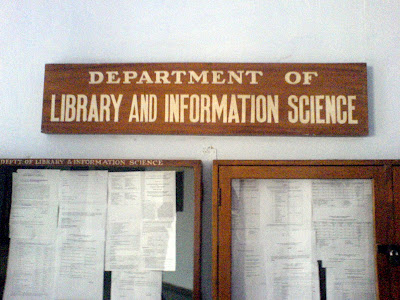

Mr. Rupak Chakravarty, a young and dynamic Lecturer of Department suggested later that I should write on OpenMED@NIC. He is computer savvy lecturer with prominent online presence. I guess he knew my interests. I decided to revisit my experiences with OpenMED@NIC and few lessons learned from it. I am of the opinion that Institutional Repositories are among the most important and immediate future strategic issues for the libraries. I took keen interest in writing the paper and completed it within the specified time frame. Went to the city beautiful on the D-day.

Panjab University has a beautiful campus. I had always admired it. It looked very familiar to me. I could feel as if the time has stopped and only new students have taken place of old students like me.


 The early morning, with street lights still on, gave a hypnotic feeling.
The early morning, with street lights still on, gave a hypnotic feeling.
The seminar started with usual inauguration session. Keynote address was interesting as the speaker was taking about open access in length. He included it in the future strategic issues. I remember, only a couple of people including myself use to speak about open access in India around the year 2004 in an email forum i.e. Lis-Forum. My turn for presentation came after lunchtime. Session chairman gave me just seven minutes, but I exceeded the time limit. I had sixty slides to show but then could just run through. This time I experimented with my slide show. I compiled number of images picked from various sources and tried to convey the points included in my paper. I think people liked the presentation but I wanted to tell more.
The diamond jubilee celebrations included many other events including some cultural events in the campus. However the Department of Library and Information Science had just the seminar.
Panjab University Library is among the most functional libraries. You will notice that noise prone areas like staff working area and staircase is at the maximum distance from the reading halls. The library stacks act as insulation wall between these. It has Four Floors, but you can enter only the First and Third Floors from the main staircase. The Second and Fourth Floors can be called as false floors as these are meant for stacks only. Entrance to these floors is from the reading halls on first and third floor. Each reading hall has a ‘Reference Desks” at one side. The position is such that the staff can easily observe the readers sitting on tables and those entering into stack areas. Now they are keeping watch in the stack areas with help of technology. The staff can observe the stack areas with closed circuit TV cameras.

Lobbies connect the main staircase area to reading halls. In the lobby of the first floor there is a long card catalogue.
 I am very familiar with this Card Catalogue. No, I did not use it much for locating books during my student life. It is familiar because I had filed cards into it during my short job period.
I am very familiar with this Card Catalogue. No, I did not use it much for locating books during my student life. It is familiar because I had filed cards into it during my short job period.

The Indian Languages Catalogue is obviously in different alphabetic series.


 But there is change now, in addition to this card catalogue, there are Web OPAC workstations kept on its sides.
But there is change now, in addition to this card catalogue, there are Web OPAC workstations kept on its sides.
Well that is not touch screen terminal. It is an ordinary workstation.
During my days, the cards were written by hand. For that staff needed a good ‘Library Hand’. Library hand is a writing style in which the words should be clearly legible and letters should not be connected with each other. I know, somewhere in the sea of cards, few would be in my handwriting. Now they don’t write with hands. Cards are generated from library software system and printed through laser printers on special stationary.


I had a nice and fruitful time during the seminar. I interacted with number of Participates, Department Staff and Students. I had heartily discussions Prof. G.C Bansal during lunch breaks. He is also one of my teachers but now retired from the Department. I also had in-depth interaction with Prof. Jagtar Singh, Prof. Sewa Singh and Prof. Satija.



2 comments:
Amazing artical.
a mazing artical about P.U .Chd with beautiful photographs.
Post a Comment